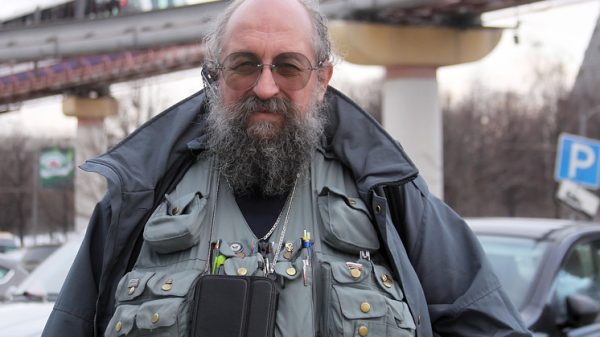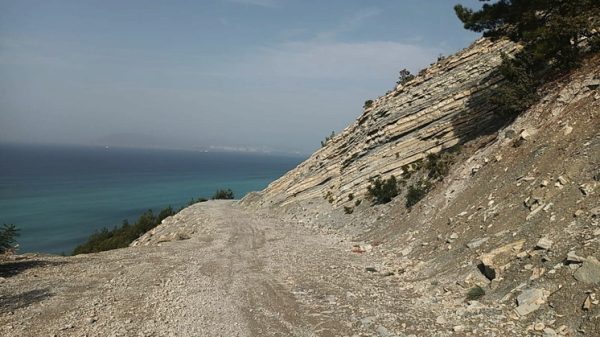
The inner sanctum of the mausoleum, surrounded by its high outer walls
Credit: City of Rome
Still imposing after 2,000 years, a vast funerary monument that was once the resting place of Rome’s emperors is to reopen to visitors on Tuesday after a €12 million restoration.
It has taken five years to restore and make safe the Mausoleum of Augustus, a fortress-like tomb for the one of the greatest of all Roman emperors, as well as his successors.
It is a place that, despite being right in the heart of the capital and just a stone’s throw from busy shopping streets, restaurants and hotels, has rarely been open to Romans during the last 80 years.

An aerial view of the Mausoleum of Augustus in the heart of Rome
Credit: City of Rome
Benito Mussolini embarked on a project to return it to its glory days back in the 1930s, wielding a pickaxe to demolish the first of 120 medieval buildings that crowded around the monument.
But the project was interrupted by the war in 1942 and Il Duce’s dreams of being buried in the mausoleum as a modern-day emperor came to an inglorious end when he was killed by partisans in northern Italy and strung up from a petrol station in Milan.
The mausoleum — the biggest circular funerary monument in the world — fell into disrepair, covered in overgrown bushes and trees, its surrounding moat the haunt of homeless people and a dumping ground for rubbish.
It has been revived with the help of a €8 million donation from TIM, an Italian telecommunications company, with the rest of the money provided by the Italian state and city of Rome.

Part of the exterior of the mausoleum, with a Renaissance church in the background
Credit: Nick Squires
“Finally the Mausoleum of Augustus is reopening and we are restoring to the world a jewel of humanity’s heritage after many years of closure,” said Virginia Raggi, the mayor of Rome. “Rome needs to make the most of its past in order to look to the future.”
The restoration of the monument should be “an important symbol for the recovery of not just the city but the whole country,” following the Covid-19 pandemic, she said.
A tall entrance leads into the monument, which consists of concentric corridors around a central cylindrical structure where the remains of Augustus and his successors, including Tiberius, Claudius and the psychotic Caligula, were kept.

A TV cameraman films the inner sanctum of the mausoleum
Credit: Nick Squires
The outer walls of the monument are high, but they were once twice as impressive, reaching nearly 150ft.
On top of the monument stood a huge bronze statue of Augustus, which has long since been lost, looted or melted down.
Vast slabs of marble litter the inner courtyard, the remains of the cladding that once adorned the 300ft-diameter monument.
Engineers carried out massive structural consolidation work, stabilising the walls and covering them with a protective layer of “pignoccata”, a special mortar mix. Iron girders and steel rods were used to reinforce vaulted ceilings.

The entrance to the mausoleum, partly restored during the Fascist era
Credit: Nick Squires
Augustus began the construction of the mausoleum – intended as a vast tomb for him and his family – in 28BC following his victorious campaign in Egypt, when he beat the combined forces of Mark Anthony and Cleopatra at the Battle of Actium in 31BC.
“Augustus built the mausoleum as a way of underlining and reinforcing his rapport with Rome, in contrast to Mark Anthony, who was living with Cleopatra and had expressed a desire to be buried in Alexandria,” Tania Renzi, a historian, told The Telegraph in the chill interior of the mausoleum.
“Augustus used architecture as a statement of political power. He built a huge bath complex and the Pantheon, but the mausoleum was the biggest project of all. Its dimensions were incredible. Every time an emperor or one of his relatives died, funeral ceremonies were held inside.”

Inside the heart of the mausoleum, built 2,000 years ago by Augustus
Credit: EPA
After the fall of the Roman Empire, the monument had a chequered history – it was converted into a fortress by the Colonna family of Rome, then became a palazzo for a wealthy Florentine banker.
In the 18th century it was used as an arena for bull-fighting. In one of its inner chambers, visitors will spot iron rings on the wall, used for tethering bulls and buffalo before they were shoved into the arena to face specially-imported Spanish toreadors.
There are also the remains of marble urinals, a legacy of the early 20th century, when the mausoleum was turned into a 3,000-seat concert hall where Toscanini, Debussy, Ravel and Stravinsky performed.
Groups of 10 visitors at a time will be allowed into the mausoleum, with facemasks compulsory.
With Italy facing a third wave of the pandemic and international travel curtailed, it will largely be Italians who will be able to rediscover the magic of the monument.
From this week until April 21 — the day on which Rome was founded in 753BC, according to legend — entrance will be free.
Visitors will notice cranes and bulldozers in the large piazza around the mausoleum – a sunken area is being turned into a pedestrian zone while a Fascist-era building decorated with murals and statues lauding Mussolini is to be converted into a five-star Bulgari hotel. The hotel is due to open next year.
The revitalisation of the area is worthy of Augustus himself – the emperor famously boasted on his death bed: “I found Rome a city of bricks and left it a city of marble.”




















































Свежие комментарии